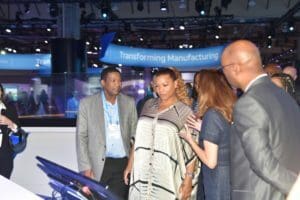Twitter Feed
2018 AT&T Business Summit: Security “in” and “of” the Cloud
While public cloud is undoubtedly an outsized piece of the conversation, news headlines of the latest data breach can make this move a very frightening proposition. The question of how…
My Brush with Royalty: Queen Latifah
Queen Latifah! Hip Hop Icon. Movie Star. Television Star. Fashion Model. Songwriter. Producer. Entrepreneurial Genius!? YES! Dana Elaine Owens, her given name, is co-owner of Flavor Unit Entertainment, a firm that includes…
What’s New in Puppet 5?
Puppet 5 is released and comes with several exciting enhancements and features that promise to make configuration management much more streamlined. This article will take a comprehensive look at these…
5 Reasons Why Ansible is the Best CM Tool Out There?
Amidst volatile markets, dynamic technology shifts, and ever-increasing customer demands, it is imperative for IT organizations to develop flexible, scalable and high-quality applications that exceed expectations and enhance productivity. A…
Machine learning APIs for Google Cloud Platform
Google Cloud Platform (GCP) is considered to be one of the Big 3 cloud platforms among Microsoft Azure and AWS. GCP is widely used cloud solutions supporting AI capabilities to design and…
What Is The Most Important Part of Architecture?
I always find it interesting to hear what people view architecture as. A lot of people think it’s just about the design aspect, where you get to put pen to…
Cloud migration best practice Part 4: Executing the migration
This series has stepped through cloud migration best practices. After providing an overview, we discussed: Classifying business-critical data. Updating organizational IT governance policies. Application screening and cloud workload selection. How to…
Cloud Migration Best Practice Part 3: Application Portfolio Analysis
In part three of this series on cloud migration best practice, I will focus on migrating the application itself. If you haven’t had the opportunity to read our recommendations from part…
Why Use Immutable Storage?
Data has become a global currency, and its value has nowhere to go but up. According to The Economist online, the world’s most valuable resource is no longer oil, but…
CLOUD ACT: What Does That Mean for Your Cloud Storage
When Congress names a law after you, it’s getting serious. That is where we are now with cloud computing. The Clarifying Lawful Overseas Use of Data Act or CLOUD Act (H.R. 4943) is…
Contrary to what your mother may have told you, going in circles is sometimes a good thing. When it comes to our economy, it is actually a great thing.
- Materials (sand, iron, gold, etc.) are evaluated for purpose and taken from nature.
- Modified and refined as necessary, these materials are combined and recombined into the services and products we use every day, until…
- Their usefulness to society wanes and the everyday products and services are disposed of in a heap of useless trash.
- Regenerative design – interdisciplinary field of inquiry concerned with a sustainable future
- Performance economy – the vision of an economy in loops (or circular economy) and its impact on job creation, economic competitiveness, resource savings, and waste prevention
- Cradle to cradle – focuses on design for effectiveness in terms of products with positive impact and reducing the negative impacts of commerce through efficiency.
- Industrial ecology – the study of material and energy flows through industrial systems
- Biomimicry – a discipline that studies nature’s best ideas and then imitates these designs and processes to solve human problems
- “Blue Economy” – uses the resources available in cascading systems and the waste of one product becomes the input to create a new cash flow
| AWARD | WINNER |
| The Fortune Award for Circular Economy Leadership | Sir Ian Cheshire |
| The Fortune Award for Circular Economy Leadership | Janez Poto?nik |
| The YGL Award for Circular Economy Entrepreneurship | Method |
| The Accenture Award for Circular Economy Pioneer | Dell Inc. |
| The BT Award for Circular Economy Digital Disruptor | Tradeshift |
| The Ecolab Award for Circular Economy Cities / Regions | Danish Business Authority |
(This post was written as part of the Dell Insight Partners program, which provides news and analysis about the evolving world of tech. To learn more about tech news and analysis visit TechPageOne. Dell sponsored this article, but the opinions are my own and don’t necessarily represent Dell’s positions or strategies.)
( Thank you. If you enjoyed this article, get free updates by email or RSS – © Copyright Kevin L. Jackson 2012)
Cloud Computing
- CPUcoin Expands CPU/GPU Power Sharing with Cudo Ventures Enterprise Network Partnership
- CPUcoin Expands CPU/GPU Power Sharing with Cudo Ventures Enterprise Network Partnership
- Route1 Announces Q2 2019 Financial Results
- CPUcoin Expands CPU/GPU Power Sharing with Cudo Ventures Enterprise Network Partnership
- ChannelAdvisor to Present at the D.A. Davidson 18th Annual Technology Conference
Cybersecurity
- Route1 Announces Q2 2019 Financial Results
- FIRST US BANCSHARES, INC. DECLARES CASH DIVIDEND
- Business Continuity Management Planning Solution Market is Expected to Grow ~ US$ 1.6 Bn by the end of 2029 - PMR
- Atos delivers Quantum-Learning-as-a-Service to Xofia to enable artificial intelligence solutions
- New Ares IoT Botnet discovered on Android OS based Set-Top Boxes




